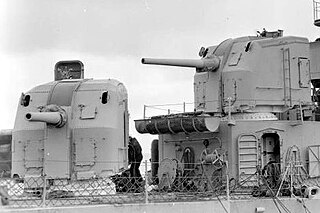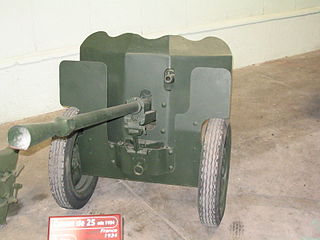
In anti-tank warfare, an anti-tank mine is a type of land mine designed to damage or destroy vehicles including tanks and armored fighting vehicles.

The Cannone da 47/32 mod. 1935 was an Italian artillery piece that saw service during World War II. It was originally designed by Austrian firm Böhler, and produced in Italy under license. The Cannone da 47/32 was used both as an infantry gun and an anti-tank gun at which it was effective against light to medium armored tanks.

The Mark 12 5"/38-caliber gun was a United States dual-purpose naval gun, but also installed in single-purpose mounts on a handful of ships. The 38-caliber barrel was a mid-length compromise between the previous United States standard 5"/51 low-angle gun and 5"/25 anti-aircraft gun. United States naval gun terminology indicates the gun fired a projectile 5 inches (127 mm) in diameter, and the barrel was 38 calibers long. The increased barrel length provided greatly improved performance in both anti-aircraft and anti-surface roles compared to the 5"/25 gun. However, except for the barrel length and the use of semi-fixed ammunition, the 5"/38 gun was derived from the 5"/25 gun. Both weapons had power ramming, which enabled rapid fire at high angles against aircraft. The 5"/38 entered service on USS Farragut, commissioned in 1934, the first new destroyer design since the last Clemson was built in 1922. The base ring mount, which improved the effective rate of fire, entered service on USS Porter, commissioned in 1936.

The PMD-6, PMD-7 and PMD-57 series mines are Soviet Union blast-type anti-personnel mines that consist of a wooden box with a hinged lid with a slot cut into it. The slot presses down against a retaining pin, which holds back the striker. When sufficient pressure is applied to the lid of the box the retaining pin moves, allowing the striker to hit the detonator. The mines typically have an operating pressure of 1 to 10 kg.
The TMD-44 and TMD-B are simple rectangular Soviet wooden box cased anti-tank blast mines, they were both used during the Second World War. Both mines are similar in design, differing only in fuzing mechanism. The wooden construction of both the mines makes them unpredictable as rot and insects can eat away the wooden case, reducing activation pressure to as little as 3 kg. Both mines are found in a number of countries including Afghanistan, Angola, Chad, Cuba, Egypt, Korea, Mozambique, Namibia, Rwanda, Yemen, Zambia and Zimbabwe.

The Maxim M/32-33 is a Finnish modification of the Russian M1910 Maxim, developed by Aimo Lahti in 1932. Lahti was ordered to adapt the Maxim so that it could be fed with more modern metallic ammunition belts as opposed to the original cloth belts. The resulting weapon was able to fire at a rate of 850 rounds/min, whereas the Russian M1910 and earlier Finnish M09-21 were only capable of 600 rounds/min. The increased rate of fire was achieved through improvements that included an accelerator mechanism and muzzle booster. Other changes included a redesign of the Maxim M/32-33's grips and rear sights, as well as an installation point for an optical sight.

The Riegel mine 43 or is a German steel cased anti-tank bar mine used during the Second World War. The mine is a long thin rectangle. It consists of a lower and upper metal tray, and an internal metal-cased explosive block. It uses two ZZ42 fuzes inserted into either end of the internal block, although it can be used with an additional pressure fuze on the top. The mine is similar to the Italian B-2 mine. A variant, the Riegel mine 44 was also produced with a different fuze. Approximately 3,051,400 were produced between 1943 and 1945.

The Panzer-Stabmine 43 was a German anti-tank mine, together with the Hohl-Sprung mine 4672 it was the first mine to combine a shaped charge warhead with a tilt-rod fuze. The mine was developed during the Second World War. The mine consisted of a wine glass shaped metal main body mounted on a wooden post, with a tilt rod holding arm projecting to one side. It used a 125 mm diameter warhead with 1.6 kg of explosive, and a combination pressure/tilt fuze.

The Panssarimiina m/36 is a Finnish anti-tank blast mine used during the Winter War, Second World War and Continuation War. The mine was the first purpose-built anti-tank mine to enter service with the Finnish Army, and was designed by Lieutenant Colonel T. Raatikainen and Lieutenant Colonel Pylkkänen. Only 5,000 were produced, as the mine proved complex to produce for a number of reasons. The fuze was complex and designed to be interchangeable with artillery fuzes, so artillery shells could be used alongside the mines, also the sheet metal case was hard to produce.

The Panssarimiina m/39 is a Finnish anti-tank blast mine used during the Winter War, Second World War and Continuation War. The mine was first developed by Major General Arvo Saloranta in October 1939, it superseded the Panssarimiina m/36 in service with the Finnish Army. It was first delivered in December 1939 while the Winter War was taking place. Though it was simpler to produce than the earlier m/36 it was still too complicated, and supply was outstripped by demand. This spawned the rapid design and development of the wooden Panssarimiina m/S-39 which could be largely produced without the use of metal working machinery.

The Panssarimiina m/S-39 and Panssarimiina m/S-40 are Finnish anti-tank blast mines used during the Winter War of 1939-1940. Russian tanks were only able to be halted by rapid production and placement of mines. Due to the demand for mines during the Winter War, a cheap, easy-to-produce mine was needed. The m/S-39 was designed by a team led by Major A. Saloranta in October 1939, and it entered production on 8 November 1939. After one week's production at furniture factories in Lahti and Helylä over 2,000 mines had been produced. By the end of the Winter War 133,000 had been delivered. The m/S-40 was an improved version of the mine that differed in detail.
The TMD-1 and TMD-2 are Yugoslavian wooden cased anti-tank blast mines, similar to the Russian TMD-B. The box consists of a wooden box, which contains the main cast TNT main charge. A webbing carrying handle is provided on one side of the mine. The fuze is placed in a central detonation well under the centre board of three that are fixed to the top of the mine. When sufficient pressure is placed on the boards, they collapse inwards, pressing on the installed fuze triggering the mine.

The 25 mm Hotchkiss anti-tank gun was a French anti-tank gun from the 1930s, built by the Hotchkiss arsenal, that saw service in the Spanish Civil War, the Second World War and the Indochina War.

The YaM-5 was a Soviet anti-tank blast mine with a wooden case. The mine was widely used during Great Patriotic War. Wood was chosen as primary material for its availability, cheapness and ease of handling; for example, in 1942, several thousand cases were produced at Tuymen Plywood Factory by patriotic young volunteers as an after-school activity. Various types of wood were used.

The Anti-Tank Mine General Service Mark II was a British anti-tank blast mine used during the Second World War.
The TMD-40 was a wooden-cased Soviet anti-tank blast mine used during the Second World War. The mine consisted of a rectangular wooden box which contained a detonator assembly at each end and seven 400 gram and four 200 gram blocks of explosive. The fuse assemblies consisted of a lever device, which when pressed downward by pressure pieces attached to the lid of the mine, see-sawed upward, pulling the striker retaining pin from a pull detonator. The main charge was then triggered.
The NV-41 was a wooden-cased Soviet anti-tank blast mine used during the Second World War. The mine consists of a square wooden box with a filling plug on the bottom. The top of the box is covered by a thin pressure lid, which covers a pressure plate held up by a spring. Sufficient pressure on the lid collapses it down onto the pressure plate. Downward movement of the pressure plate moves down a pressure plunger, which in turn levers up the striker retaining lever, releasing the spring-loaded striker and allowing it to impact the stab sensitive detonator, triggering the main charge.

The Holzmine 42 was an anti-tank mine that was developed by Germany and used by the Wehrmacht during World War II.

The B-Stabmine (Behelfs-Stabmine) or Makeshift Stickmine in English was an anti-tank mine that was developed by Germany and used by the Wehrmacht during World War II.














